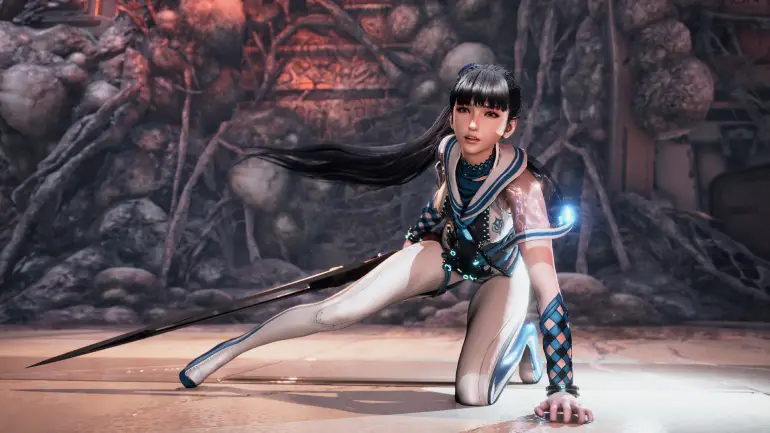Stellar Blade presents an identity crisis in its gameplay that leaves players pondering its true genre. The main character, Eve, is designed with the attributes of a classic action game heroine, complete with dynamic special moves reminiscent of the hack-and-slash era. Yet, her movement lacks the necessary agility and finesse when she is not engaged in combat, detracting from her otherwise polished warrior image. Furthermore, the game introduces a series of formidable bosses that demand precise parrying skills akin to those found in Soulsborne games.
However, this comparison falls short as the complexity and depth typically associated with Soulsborne games do not permeate the rest of Stellar Blade's gameplay. The boss fights might echo this hardcore style, but the regular enemy encounters and the game world do not sustain this rigor, leading to a somewhat disjointed gaming experience. This inconsistency makes Stellar Blade a curious hybrid that struggles to fully satisfy the conventions of either genre it seems to draw from.
Gameplay Identity Crisis
Stellar Blade presents itself as an enigmatic fusion of gaming elements that, while individually promising, struggle to harmonize into a cohesive experience. At its core, the game showcases flashes of brilliance, suggesting that not one, but two potentially great games could emerge from its framework. However, this strength paradoxically becomes its weakness. These divergent aspects frequently clash rather than complement each other, creating a palpable tension that detracts from the overall enjoyment.
This identity crisis in Stellar Blade goes beyond mere genre classification, influencing its narrative depth, gameplay mechanics, and visual style. Each component competes for dominance rather than working in concert, leading to a product that, while good in its aspirations and moments of achievement, stops short of achieving greatness due to its lack of unified direction.
Narrative Depth vs. Visual Spectacle
Stellar Blade often garners critiques for prioritizing aesthetics over a well-structured narrative, seemingly placing more emphasis on visual spectacle than on cohesive storytelling. The game features a succession of boss battles that appear more as obligatory hurdles than integral parts of a thoughtfully crafted plot. This approach can disrupt the flow and immersion, leaving players to navigate through a storyline that feels contrived and overly predictable.
Despite its visually striking world and detailed character design, the game struggles to weave these elements into a compelling narrative, often foreshadowing major plot developments with little subtlety. In comparison to games like Nier: Automata, which skillfully blend deep, engaging storytelling with their gameplay and artistic elements, Stellar Blade seems to miss the mark, relying heavily on its stylistic components at the expense of narrative depth.
Unraveling Eve's Enigma
The issue with prioritizing style over substance in video games is that it often leads to a lack of depth in character development and gameplay, which can be clearly seen in instances like Stellar Blade. While the game boasts visually appealing moments and creatively designed adversaries, its protagonist, Eve, suffers from a noticeable absence of meaningful character traits or development. Eve's portrayal, exemplified by a viral clip where she slides down a ladder in an exaggerated pose, captures all the flair without embedding any substantial personality or engaging backstory.
This superficiality makes her feel more like a bystander in her own story rather than a dynamic and influential protagonist, ultimately detracting from the player's experience by prioritizing visual spectacle over a compelling narrative and character engagement.
The critique of “Stellar Blade” often treads a contentious line between character portrayal and audience perception, particularly regarding its protagonist, Eve. While some may argue that any criticism directed at the game stems from an inability to accept a sexually appealing female lead, it's essential to delve deeper into Eve's character beyond her physical appearance. Despite the option to outfit Eve in various provocative costumes, these aesthetic choices do not inherently bestow sexuality upon her character.

In the game, Eve's interactions and demeanor are marked by a certain aloofness, and the narrative does not leverage her attire for character development or plot progression. Thus, labeling criticism of “Stellar Blade” as mere discomfort with sexuality overlooks the nuances of character execution and the broader discussions about how female characters are portrayed in video games.
Eve's character design in the game presents an intriguing contrast in the realm of video game aesthetics. Unlike Rayne or Bayonetta, whose appearances and movements are intentionally crafted to be overtly seductive and appealing, Eve's allure seems unintentionally understated. Clad in revealing attire and possessing exaggerated physical animations, she paradoxically exhibits a nonchalant demeanor that neither capitalizes on nor acknowledges her own physical attractiveness
Her interactions with other characters, who often meet her with indifference or boredom, further mystify her appeal. This disconnect raises questions about the intentions behind her character design and whether she is perceived as conventionally attractive within the game's universe. The game's ambiguity leaves players pondering the true nature of Eve's allure, subtly challenging traditional norms of character attractiveness and engagement.
It feels odd to be criticising a game for not making its pretty female characters twerk for my amusement, but given how hard Eve has been pushed as a frontline soldier in the culture war – including the developers emphasising the time spent designing the bounce of her behind and adding a naked costume as a pseudo-hard mode, it's odd to see the final result. Maybe it was a reservation over being criticised for being exploitative, swinging past the Bayonetta sweet spot into Quiet's skin breathing. Or maybe developer Shift Up is simply better at animating beautiful women than it is at writing them.
It does seem paradoxical to critique a game for not including more sexualized animations of its female characters, especially when the developers have already emphasized certain aesthetic aspects, such as the bounce of a character's posterior and even incorporating a revealing costume as part of a gameplay challenge. This contradiction highlights a broader issue within the gaming industry regarding the representation of female characters.
The developers, Shift Up, may have intended to create a controversial buzz by initially focusing on these elements, but perhaps pulled back due to fear of backlash for overt sexualization, missing what some see as a ‘sweet spot' found in games like Bayonetta. It raises questions about the balance between character design and character depth, suggesting that perhaps the studio excels more in visual design than narrative depth or character development. This situation underscores the ongoing tension between creating visually appealing characters and avoiding exploitative representations, a challenge that continues to evolve in the gaming community.
Despite my numerous reservations about the game’s ability to effectively belong in the character action or Soulsborne genres, its narrative simplicity, and its general failure in articulating its themes, I found myself oddly entertained. It's a peculiar scenario; on one hand, the game struggles to meet the expectations set by its genre predecessors, lacking depth and complexity in both mechanics and story.
On the other, there’s an undeniable charm or perhaps a guilty pleasure in engaging with its flawed dynamics. This contradiction makes my feelings toward the game whirl in a cyclone of conflict — I recognize its shortcomings, yet I cannot dismiss the fact that I experienced a certain level of enjoyment while navigating through its challenges. It's this enigmatic allure that keeps my sentiments ensnared in a perplexing, yet unmistakably real, enjoyment of the game.
In the captivating world of Stellar Blade, players are treated to a visually rich and decadent exploration experience that transcends typical gaming environments. The game's journey takes one through an array of hauntingly beautiful yet desolate landscapes, from sprawling desert wastelands to eerie, abandoned subway tunnels and structurally compromised bridges. Each setting is meticulously crafted, imbuing a sense of desolation and abandonment that is both captivating and chilling.

Stellar Blade delves into the grotesque with its exploration of twisted and disease-ridden scientific facilities, each hosting a variety of enemies whose uniquely unsettling sound design adds a layer of auditory horror. This commitment to atmospheric detail and enemy individuality serves not only to enhance the gaming experience but also to inject a fresh vitality into classic video game locales, setting Stellar Blade apart in a crowded genre.
The boss battles in the game are meticulously crafted to strike the perfect balance between challenge and achievability, ensuring that players are tested but not overwhelmed. Each boss stands out with its unique design and requires a distinct strategy to defeat, which prevents the gameplay from becoming monotonous. As the protagonist, Eve, progresses through the game, she acquires new abilities, ensuring that players have fresh tactics to employ in these epic confrontations. This continuous evolution in gameplay, coupled with the grand scale and complexity of the boss battles, adds a thrilling layer of depth and engagement to the game, keeping players eagerly anticipating each new colossal encounter.
Gameplay Dynamics and Challenges
The cyclone of novelty and exploration in the game spins with a compelling force, promising new vistas and challenges that beckon the adventurous spirit. However, this same whirlwind of potential is marred by some incredibly frustrating platform mechanics, arguably among the least forgiving in recent memory. Players face abrupt deactivations of crucial abilities like the double jump at critical moments, undermining the precision and timing developed throughout gameplay.
Eve exhibits an erratic behavior where she unpredictably bounces off platforms or fails to adhere to surfaces correctly. This inconsistency extends to the ledge-grabbing mechanics where there’s no reliable pattern or logic to which edges can be grasped for safety and which cruelly lead to a plummet. These elements combine to create a platforming experience that oscillates between exhilaration and exasperation, leaving players spinning in a cyclone of unpredictability.
In the unforgiving world of this game, the challenges posed by bosses are heightened by a stringent resource management system that tests the player's strategic acumen. Not only is ammunition for ranged weapons a rare commodity, it can only be replenished by dipping into Eve's already limited funds, adding a layer of financial strategy to each encounter. Each failed attempt against a boss results in the boss regenerating to full health, while the player must pay again for ammunition. Furthermore, the healing mechanics introduce an additional tactical hurdle. Players are equipped with rechargeable health packs, which increase in number as they progress through the game.
Regardless of how many health packs a player has accumulated—be it two or sixteen—only two can be used during any single battle. Additionally, players are further constrained by the ability to use a revival kit only once per battle, no matter how many they possess, forcing them to approach each boss fight with a well-thought-out plan for both offense and survival. This combination of financial and resource-based strategy layers the gameplay with a demanding, yet engaging, complexity.
In the gameplay mechanics of Stellar Blade, Eve's healing animation presents a significant challenge due to its lengthy duration and the fact that it only restores health upon completion. This issue is exacerbated by the animation's inconsistent activation, which can leave players vulnerable at critical moments. Furthermore, the design choice to assign both parry and Eve's special attacks to the same button frequently leads to unintended actions, as players attempting to execute one function might inadvertently trigger the other.
While learning enemy patterns and mastering timing are quintessential aspects of the Soulsborne genre, these overlapping controls and delayed healing can often lead to deaths that feel unfair, fostering frustration rather than a sense of accomplishment. This can detract from the overall experience, as it sometimes feels like the game's mechanics, rather than player error, are to blame for the failures.
Verdict
Stellar Blade presents a paradoxical gaming experience, intertwining moments of brilliance with elements of tedium. On one hand, the combat system stands out with its innovative mechanics, offering both satisfaction and unique challenges; however, this novelty is often overshadowed by repetitiveness that can diminish the overall enjoyment. Visually, the game dazzles, showcasing a level of artistry that promises more than what its narrative and gameplay depth deliver. It teeters on the edge of greatness, hinting at a potential that remains frustratingly unfulfilled.
While playing Stellar Blade can indeed be a delightful experience, it's hard to shake the feeling that with a bit more refinement and focus, it could have been a benchmark for others to follow. The lingering sense of what might have been infuses the game with an undercurrent of disappointment, despite the genuine fun it offers.






